The Japan Society for the Promotion of Science (JSPS) Washington Office and the Fogarty International Center (FIC) at the National Institutes of Health (NIH) held the 2021 JSPS-NIH Forum on March 5, 2021 as a virtual forum.
The JSPS-NIH Fellowship for Japanese Biomedical and Behavioral Researchers at NIH (JSPS-NIH Fellowship or “Kaitoku-NIH”) is an annual fellowship that provides funds for about ten Japanese biomedical and behavioral scientists to conduct two years of research at NIH. JSPS is the funding agency while the NIH is the nominating authority.
The 2021 Forum featured invited speaker presentations by Dr. Hiroaki Wake, a Professor at the Graduate School of Medicine, Nagoya University, and by Dr. Michael Gottesman, Deputy Director for Intramural Research at NIH. The invited speakers were followed by the ten incoming fellows that were awarded in FY2020, and starting their fellowships either from January, February or March 2021, who spoke about their research plans for their fellowship period at NIH.
The Forum began with opening remarks by Dr. Kohji Hirata, the Director of the JSPS Washington Office; Mr. Seiichi Shimasaki, the Science Counselor of the Embassy of Japan in the US; and Dr. Yoh-suke Mukouyama, Senior Investigator at NHLBI and Chair of the Review Panel of the JSPS-NIH Fellowship.
Dr. Hirata noted that it would soon be the ten year anniversary of the Great East Japan earthquake and the accident at the Fukushima Daiichi Nuclear Station, and expressed his gratitude for the help provided by the United States during the disaster, including support from NIH. He emphasized that the Kaitoku-NIH Fellowship is an important aspect of the long and successful history of scientific cooperation between the U.S. and Japan, and many alumni of the fellowship have gone on to have very successful careers in Japan.
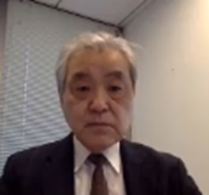
Opening Remarks (Dr. Kohji Hirata, JSPS Washington Office)
Mr. Shimasaki congratulated the program awardees for their hard work and resilience in their research efforts despite the challenges for research posed by the COVID-19 pandemic. He suggested the creation of a Kaitoku-NIH alumni network, so that both former and current participants can benefit from their shared knowledge.
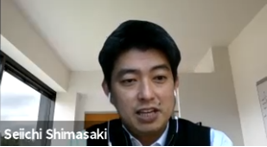
Dr. Mukouyama discussed the activities of the fellowship program in 2020, including their first virtual review panel meeting last summer. He encouraged the program awardees to consider some of the valuable lessons from the pandemic, such as taking new approaches to programs, and opportunities for new collaborations.
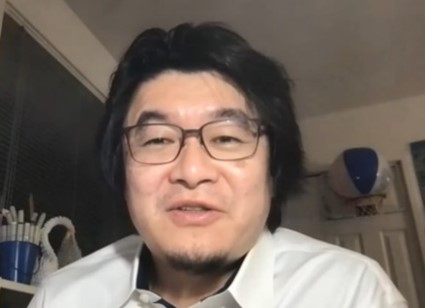
Invited Speaker #1: Dr. Hiroaki Wake, Professor, Graduate School of Medicine, Nagoya University
Dr. Wake spoke about his research on the physiological and pathological functions of microglia, a type of cell located throughout the brain and spinal cord. The brain receives senses such as vision and sound, which then inform the function of higher brain functions. These senses are reliant on neurons and glia, which each have a hierarchical function in the development of brain functions, and any abnormalities in this development can contribute to neurological disorders such as schizophrenia. Dr. Wake’s research focus was to find ways to visualize these hierarchical functions in the brain, in order to better understand the impact of microglia on physiological functions and their implications for psychiatric diseases.
Dr. Wake used in vivo two photon microscopes scanning the brain’s surface to visualize the development of microglia cells in living, conscious mice. Through this process, his team could visualize and track the development of brain neurons over the course of a year. They found that the microglial modification of synaptic functions regulates the synchronization of neural populations and is essential for the development of healthy learning processes. They further found that microglia contribute to inter-sensory connections, and if the brain loses some sensory inputs then the microglia influence the development of other sensory areas. He concluded by presenting a new holographic microscope system that his lab developed for neuroscience applications such as real-time 3D “multi spot simulation” and monitoring cell activity.
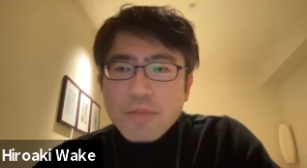
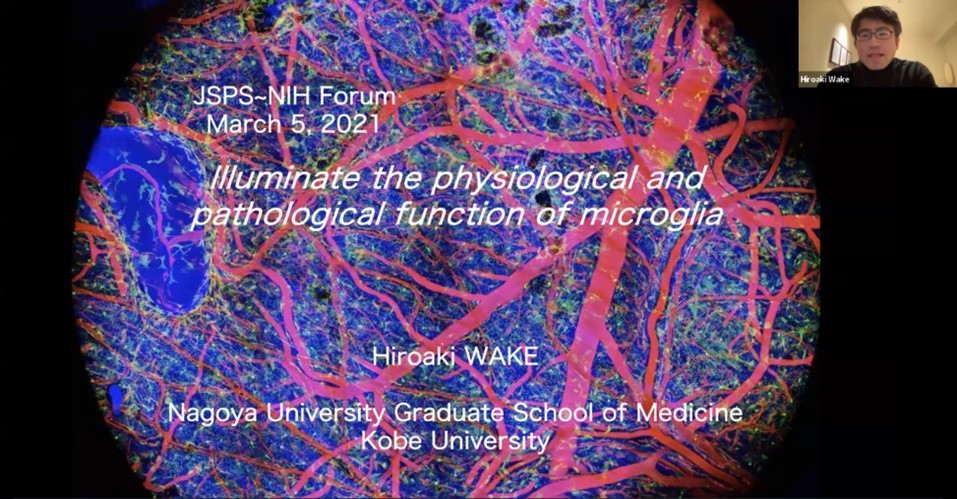
Presentation by Dr. Hiroaki Wake, Nagoya University
Invited Speaker #2: Dr. Michael Gottesman, Deputy Director for Intramural Research, NIH
Dr. Gottesman began his lecture by dedicating it to the many victims of the Great East Japan earthquake, the many scientific colleagues at Tohoku University who showed enormous resilience in rebuilding a world-class university in Sendai, Japan, and the many organizations and people who held out a hand of friendship and help in that time of peril, including through the Japan-NIH partnership.
He presented on his work on tools to study and reverse multi-drug resistance (MDR). He highlighted his collaborations with Japanese researchers who have made significant contributions to this field, including Dr. Shinichi Akiyama, Dr. Kazumitsu Ueda, Dr. Yoshikazu Sugimoto, and Dr. Takashi Tsuruo. Dr. Gottesman’s research has focused on ATP-binding cassette (ABC) transporters, which play excretory (movement) and/or protective physiological roles in several areas of the body, including at the blood-brain barrier, where they appear to play a major role in preventing drugs from effectively entering the brain to treat neurological disorders. Approximately 50% of human cancers express an energy dependent efflux multidrug efflux pump (called P-gp, or ABCB1) at levels sufficient to confer drug resistance. Based on how ABCB1 is present in many types of cancers, they concluded that it is sufficient for MDR, but may not be necessary or the only cause of drug resistance in cancer.
Research on acute myelogenous leukemia (AML) has found that AML that was responsive to chemotherapy but then developed MDR is extremely heterogenous in the expression of ABC transporters. Dr. Gottesman believes that the best therapy for AML will require a personalized approach that defines which transporters are expressed at relapse, which could improve the choice of inhibitors for that patient. He concluded by presenting recent research in mice and zebrafish on whether inhibiting two types of ABC transporters at the blood-brain barrier could dramatically aid the penetration of several chemotherapeutic agents into the brain.
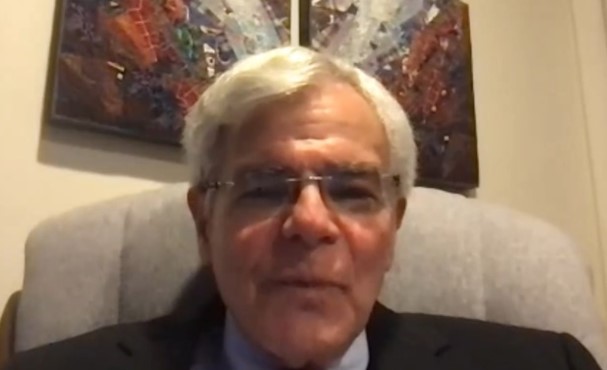
Invited Speaker Presentation (Dr. Michael Gottesman, NIH)

Presentations on Research Plan at NIH by JSPS-NIH Fellows (KAITOKU-NIH) Awarded in FY2020
The ten FY2020 JSPS-NIH fellowship recipients each gave brief “flash talk” presentations on their background and research plans. Their research plans are briefly described below.
Dr. Ryo Sato, a fellow at the National Heart, Lung, and Blood Institute (NHLBI), presented on his research on idiopathic pulmonary fibrosis (IPF), a fatal lung disease with few effective drug treatments. With lung injury model in mice, he has found a unique fibroblast (a connective tissue cell) with neuronal properties that emerges in IPF, and is studying its characteristics to hopefully lead to the development of a novel therapeutic strategy for IPF patients.
Dr. Takanobu Tagawa, a fellow at the National Cancer Institute (NCI), spoke about his plan to identify circular RNAs that regulate oncogenic viruses, and reveal interactions as potential targets of treatment.
Dr. Kei Kudo, a fellow at the NCI, is studying how targeting the metabolism of ovarian cancers with Aldehyde-dehydrogenase (ALDH)1 inhibitors can lead to the development of a new therapeutic strategy.Dr. Hiroshi Ichise, a fellow at the National Institute of Allergy and Infectious Diseases (NIAID), is studying an imaging method to analyze COVID-19 patient tissue samples to understand the complicated immunopathology and find actionable treatments.
Dr. Hiroshi Ichise, a fellow at the National Institute of Allergy and Infectious Diseases (NIAID), is studying an imaging method to analyze COVID-19 patient tissue samples to understand the complicated immunopathology and find actionable treatments.
Dr. Naoko Tsuji, a fellow at the National Institute of Diabetes and Digestive and Kidney Diseases (NIDDK), is conducting non-invasive optical imaging of the kidneys to measure superoxide production in a live mouse to study predictive biomarkers that can be used in precision medicine applications.
Dr. Yurika Yamada, a fellow at NHBLI, aims to visualize the structural basis of muscle fibers, focusing on how certain proteins form complexes in intracellular macromolecular assembly.
Dr. Masahiro Nishi, a fellow at NHLBI, has a research background in cardiovascular research, machine learning, and health policy. He plans to study mitochondrial stress-induced heart failure using mouse models. His plan includes a machine learning approach for the prediction modeling component of the research.
Dr. Kazuki Obashi, a fellow at NHLBI, is conducting nanoscale analysis of the molecular architecture of clathrin mediated endocytosis, a key process by which cells absorb metabolites, hormones, proteins, and some viruses. He is combining first-hand microscopy and light-electron microscopy to better understand the molecular interactions involved in the process.
Dr. Tsubasa Okano, a fellow at the National Institute of Arthritis and Musculoskeletal and Skin Diseases (NIAMS), is conducting a study on ‘CRISPR-KO screen for super-enhancer regulated genes in B cells’, in which he will sequence more than 50 genes regulated by super-enhancers to detect some fundamental mechanisms that are regulating the behaviors of super-enhancers.
Dr. Yuto Kagawa, a fellow at the Eunice Kennedy Shriver National Institute of Child Health and Human Development (NICHD), is studying the mechanisms of protozoan parasites and how they invade host cells. His research will combine classic electrophysiology with novel reverse genetics.
Closing Remarks
The closing remarks were delivered by Dr. Keiko Ozato, Former Chair of Review Panel, NICHD, and by Dr. Peter Kilmarx, Deputy Director, Fogarty International Center.
Dr. Ozato spoke about the founding of the Kaitoku-NIH Fellowship, and highlighted the value of the fellowship’s peer review model and its benefits for scientific process. She closed by reminding the audience that the fellowship has faced crises in the past which could have ended the program, but that they were able to overcome those crises due to the strong partnership that has been built, and through the shared belief in science and confidence that it contributes to humanity in a large way.
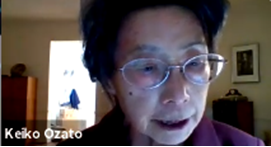
Closing Remarks (Dr. Keiko Ozato, Former Chair of Review Panel, Eunice Kennedy Shriver National Institute of Child Health and Human Development (NICHD))
Dr. Kilmarx congratulated the fellows on their achievements, and thanked the many staff and organizations that have helped to make the fellowship a success. He expressed NIH’s value and support for the Kaitoku-NIH Fellowship as an important bilateral collaboration, and that they were very pleased that 23 early career researchers applied for the fellowship despite all of the challenges presented by the COVID-19 pandemic. He noted that the top 10 candidates selected for the fellowship included two female researchers. NIH leadership is very focused on gender equity in all aspects of the biomedical workforce, and supports and encourages a richness in the breadth of the various perspectives from having a pool of highly talented scientists with diverse backgrounds, and they hope that more female researchers will apply to the program in future years.
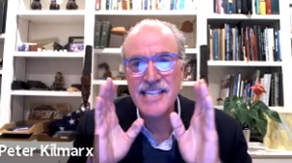
Closing Remarks (Dr. Peter Kilmarx, Fogarty International Center, NIH)
Networking
After the closing remarks, there was a networking session held in a virtual space. Participants enjoyed conversation with others.







